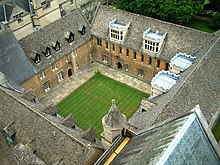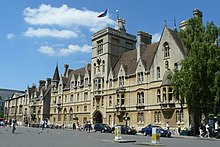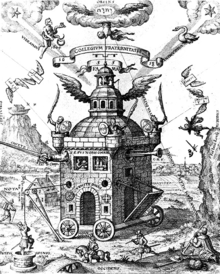"Oxford University" redirects here. For other uses, see Oxford University (disambiguation).
 | |
| Latin: Universitas Oxoniensis | |
Other name | The Chancellor, Masters and Scholars of the University of Oxford[1] |
|---|---|
| Motto | Latin: Dominus illuminatio mea |
Motto in English | The Lord is my light |
| Type | Public research university |
| Established | c. 1096[2] |
| Endowment | £8.12 billion (2022; including colleges)[5] |
| Budget | £2.924 billion (2022/23)[6] |
| Chancellor | The Lord Patten of Barnes |
| Vice-Chancellor | Irene Tracey[7] |
Academic staff | 6,945 (2022)[8] |
| Students | 26,497 (2022)[9][10] |
| Undergraduates | 12,580 |
| Postgraduates | 13,445 |
Other students | 430 |
| Location | , England 51°45′18″N 01°15′18″W |
| Campus | University town |
| Colours | Oxford Blue[11] |
| Affiliations | |
| Website | ox |
 | |
The University of Oxford is a collegiate research university in Oxford, England. There is evidence of teaching as early as 1096,[2] making it the oldest university in the English-speaking world and the world's second-oldest university in continuous operation.[2][12][13] It grew rapidly from 1167, when Henry II banned English students from attending the University of Paris.[2] After disputes between students and Oxford townsfolk in 1209, some academics fled north-east to Cambridge where they established what became the University of Cambridge.[14] The two English ancient universities share many common features and are jointly referred to as Oxbridge.[15]
The University of Oxford is made up of thirty-nine semi-autonomous constituent colleges, four permanent private halls, and a range of academic departments which are organised into four divisions.[16] Each college is a self-governing institution within the university, controlling its own membership and having its own internal structure and activities. All students are members of a college.[17] It does not have a main campus, and its buildings and facilities are scattered throughout the city centre. Undergraduate teaching at Oxford consists of lectures, small-group tutorials at the colleges and halls, seminars, laboratory work and occasionally further tutorials provided by the central university faculties and departments. Postgraduate teaching is provided in a predominantly centralised fashion.
Oxford operates the Ashmolean Museum, the world's oldest university museum; Oxford University Press, the largest university press in the world; and the largest academic library system nationwide.[18] In the fiscal year ending 31 July 2023, the university had a total consolidated income of £2.92 billion, of which £789 million was from research grants and contracts.[6]
Oxford has educated a wide range of notable alumni, including 30 prime ministers of the United Kingdom and many heads of state and government around the world.[19] As of October 2022, 73 Nobel Prize laureates, 4 Fields Medalists, and 6 Turing Award winners have matriculated, worked, or held visiting fellowships at the University of Oxford, while its alumni have won 160 Olympic medals.[20] Oxford is the home of numerous scholarships, including the Rhodes Scholarship, one of the oldest international graduate scholarship programmes.
History[edit]


Founding

The University of Oxford's foundation date is unknown.[21] It is known that teaching at Oxford existed in some form as early as 1096, but it is unclear when the university came into being.[2] Scholar Theobald of Étampes lectured at Oxford in the early 1100s.
It grew quickly from 1167 when English students returned from the University of Paris.[2] The historian Gerald of Wales lectured to such scholars in 1188, and the first known foreign scholar, Emo of Friesland, arrived in 1190. The head of the university had the title of chancellor from at least 1201, and the masters were recognised as a universitas or corporation in 1231.[2][22] The university was granted a royal charter in 1248 during the reign of King Henry III.[23]
After disputes between students and Oxford townsfolk in 1209, some academics fled from the violence to Cambridge, later forming the University of Cambridge.[14][24]
The students associated together on the basis of geographical origins, into two 'nations', representing the North (northerners or Boreales, who included the English people from north of the River Trent and the Scots) and the South (southerners or Australes, who included English people from south of the Trent, the Irish and the Welsh).[25][26] In later centuries, geographical origins continued to influence many students' affiliations when membership of a college or hall became customary in Oxford. In addition, members of many religious orders, including Dominicans, Franciscans, Carmelites and Augustinians, settled in Oxford in the mid-13th century, gained influence and maintained houses or halls for students.[27] At about the same time, private benefactors established colleges as self-contained scholarly communities. Among the earliest such founders were William of Durham, who in 1249 endowed University College,[27] and John Balliol, father of a future King of Scots; Balliol College bears his name.[25] Another founder, Walter de Merton, a Lord Chancellor of England and afterwards Bishop of Rochester, devised a series of regulations for college life;[28][29] Merton College thereby became the model for such establishments at Oxford,[30] as well as at the University of Cambridge. Thereafter, an increasing number of students lived in colleges rather than in halls and religious houses.
In 1333–1334, an attempt by some dissatisfied Oxford scholars to found a new university at Stamford, Lincolnshire, was blocked by the universities of Oxford and Cambridge petitioning King Edward III.[31] Thereafter, until the 1820s, no new universities were allowed to be founded in England, even in London; thus, Oxford and Cambridge had a duopoly, which was unusual in large western European countries.[32][33]
Renaissance period

The new learning of the Renaissance greatly influenced Oxford from the late 15th century onwards. Among university scholars of the period were William Grocyn, who contributed to the revival of Greek language studies,[34] and John Colet, the noted biblical scholar.[35]
With the English Reformation and the breaking of communion with the Roman Catholic Church, recusant scholars from Oxford fled to continental Europe, settling especially at the University of Douai.[36] The method of teaching at Oxford was transformed from the medieval scholastic method to Renaissance education, although institutions associated with the university suffered losses of land and revenues. As a centre of learning and scholarship, Oxford's reputation declined in the Age of Enlightenment; enrolments fell and teaching was neglected.[37]
In 1636,[38] William Laud, the chancellor and Archbishop of Canterbury, codified the university's statutes. These, to a large extent, remained its governing regulations until the mid-19th century. Laud was also responsible for the granting of a charter securing privileges for the University Press, and he made significant contributions to the Bodleian Library, the main library of the university. From the beginnings of the Church of England as the established church until 1866, membership of the church was a requirement to receive the BA degree from the university and "dissenters" were only permitted to receive the MA in 1871.[39]
The university was a centre of the Royalist party during the English Civil War (1642–1649), while the town favoured the opposing Parliamentarian cause.[40]

Wadham College, founded in 1610, was the undergraduate college of Sir Christopher Wren.
Wren was part of a brilliant group of experimental scientists at Oxford in the 1650s, the Oxford Philosophical Club, which included Robert Boyle and Robert Hooke. This group, which has at times been linked with Boyle's "Invisible College" held regular meetings at Wadham under the guidance of the college's Warden, John Wilkins, and the group formed the nucleus that went on to found the Royal Society.




